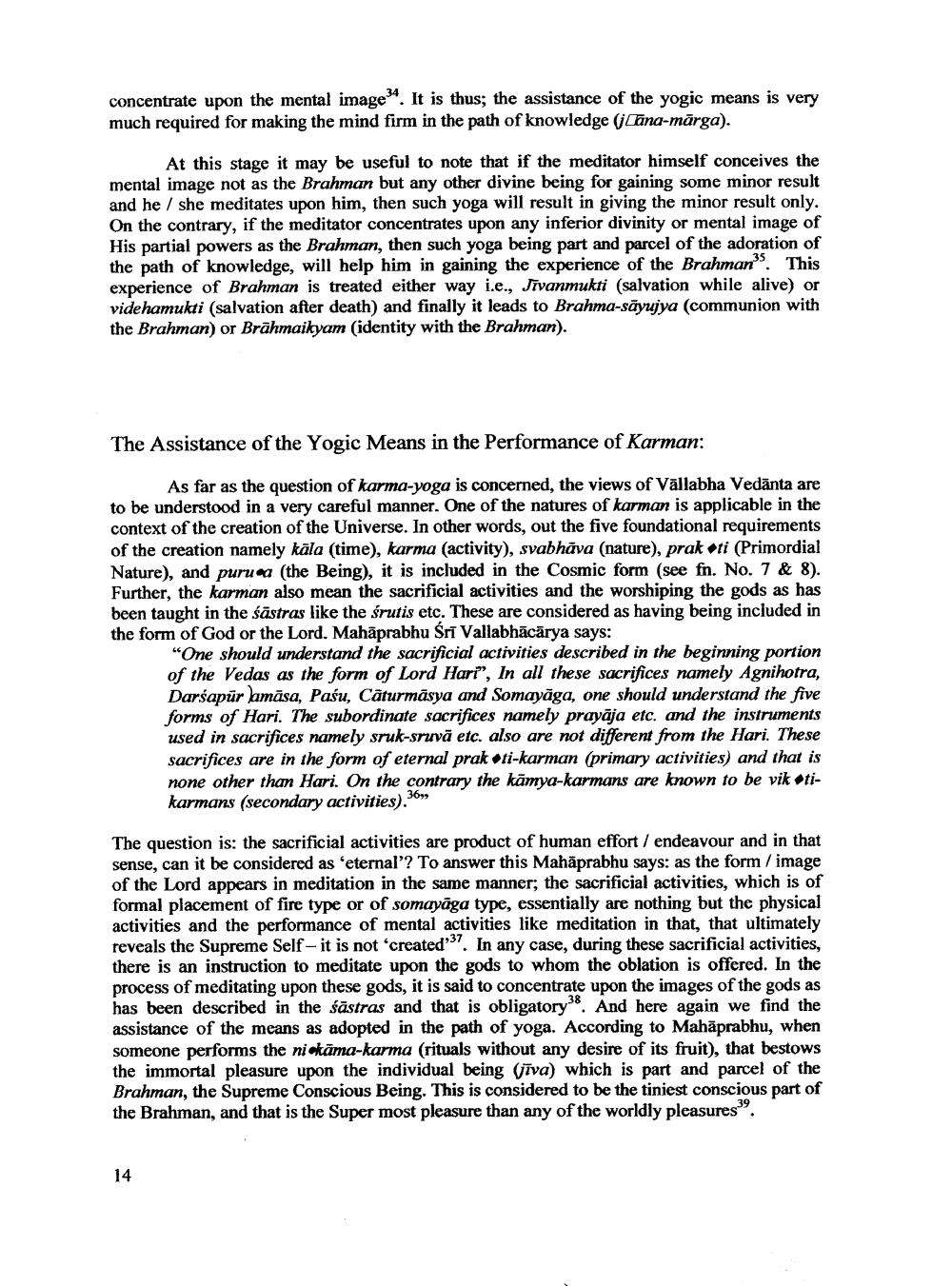________________
concentrate upon the mental image34. It is thus; the assistance of the yogic means is very much required for making the mind firm in the path of knowledge (jina-mārga).
At this stage it may be useful to note that if the meditator himself conceives the mental image not as the Brahman but any other divine being for gaining some minor result and he/she meditates upon him, then such yoga will result in giving the minor result only. On the contrary, if the meditator concentrates upon any inferior divinity or mental image of His partial powers as the Brahman, then such yoga being part and parcel of the adoration of the path of knowledge, will help him in gaining the experience of the Brahman". This experience of Brahman is treated either way i.e., Jivanmukti (salvation while alive) or videhamukti (salvation after death) and finally it leads to Brahma-sayujya (communion with the Brahman) or Brühmaikyam (identity with the Brahman).
The Assistance of the Yogic Means in the Performance of Karman:
As far as the question of karma-yoga is concerned, the views of Vallabha Vedanta are to be understood in a very careful manner. One of the natures of karman is applicable in the context of the creation of the Universe. In other words, out the five foundational requirements of the creation namely käla (time), karma (activity), svabhāva (nature), prakti (Primordial Nature), and purua (the Being), it is included in the Cosmic form (see fn. No. 7 & 8). Further, the karman also mean the sacrificial activities and the worshiping the gods as has been taught in the sastras like the śrutis etc. These are considered as having being included in the form of God or the Lord. Mahaprabhu Śrī Vallabhācārya says:
"One should understand the sacrificial activities described in the beginning portion of the Vedas as the form of Lord Hari", In all these sacrifices namely Agnihotra, Darsapur amāsa, Pasu, Caturmasya and Somayaga, one should understand the five forms of Hari. The subordinate sacrifices namely prayaja etc. and the instruments used in sacrifices namely sruk-sruva etc. also are not different from the Hari. These sacrifices are in the form of eternal prakti-karman (primary activities) and that is none other than Hari. On the contrary the kamya-karmans are known to be vik♦tikarmans (secondary activities).
3699
The question is: the sacrificial activities are product of human effort / endeavour and in that sense, can it be considered as 'eternal'? To answer this Mahaprabhu says: as the form /image of the Lord appears in meditation in the same manner; the sacrificial activities, which is of formal placement of fire type or of somayaga type, essentially are nothing but the physical activities and the performance of mental activities like meditation in that, that ultimately reveals the Supreme Self-it is not 'created'37. In any case, during these sacrificial activities, there is an instruction to meditate upon the gods to whom the oblation is offered. In the process of meditating upon these gods, it is said to concentrate upon the images of the gods as has been described in the sastras and that is obligatory38. And here again we find the assistance of the means as adopted in the path of yoga. According to Mahaprabhu, when someone performs the nikama-karma (rituals without any desire of its fruit), that bestows the immortal pleasure upon the individual being (jiva) which is part and parcel of the Brahman, the Supreme Conscious Being. This is considered to be the tiniest conscious part of the Brahman, and that is the Super most pleasure than any of the worldly pleasures 39.
14




